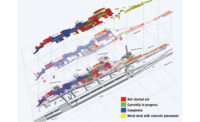A positioning system for tracking people and assets on jobsites is undergoing pilot tests in preparation for release to market in the first quarter of 2016. Early adopters are impressed.
The system from Redpoint Positioning Corp., Brookline, Mass., is emerging from stealth mode after three years of development, says CEO Antti Korhonen. When demonstrated at the ENR FutureTech East conference in New York City on Oct. 1, it was integrated with a 2D plan-based jobsite mapping system, “Project Atlas,” which is being developed by two technologists from Rogers-O’Brien Construction (ENR 10/12 p. 8).
Korhonen says the Redpoint technology uses an ultra-wideband frequency that penetrates walls and achieves horizontal location accuracy to within 8 inches. Contractors Skanska USA Building, Bechtel and Rogers-O’Brien are testing it, Korhonen says. Skanska has conducted initial trials and is starting a full pilot, which is set to run until the end of the year on a project in Boston.
The hardware consists of transmitter/receiver nodes spaced about 50 meters apart at a jobsite and registered in a building information model. They track tags in motion and map locations with operations software accessible from a desktop console or tablets in the field.
Redpoint also plans to sell an analytics package and safety vests, which have built-in warning signals that activate when workers step into areas flagged as danger zones. After initial hardware cost, pricing is expected to be subscription-based.
The nodes can run on rechargeable batteries that last three to six months. When the building is wired, it can switch to permanent power.
“This is the first GPS-like solution in the construction industry with real-time positioning and zero latency,” claims Korhonen. “As GPS is for mapping outdoors, Redpoint is for BIM. We can put that dot on the map indoors.”
“The technology does work in a construction environment,” says Tony Colonna, Skanska USA’s senior vice president for innovative construction solutions. “We wanted to see if it works, and it did.”




Post a comment to this article
Report Abusive Comment